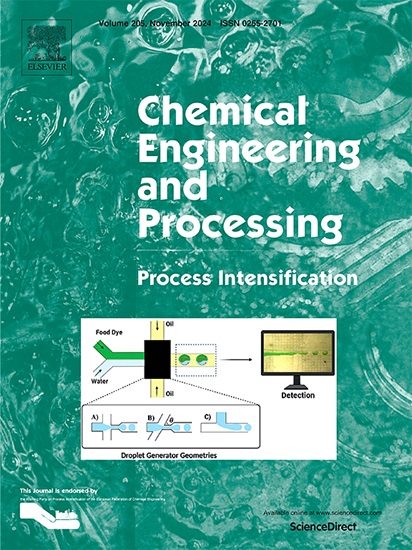Preparation of yttrium carbonate using ultrasound-assisted sodium carbonate system
IF 3.8
3区 工程技术
Q3 ENERGY & FUELS
Chemical Engineering and Processing - Process Intensification
Pub Date : 2025-05-13
DOI:10.1016/j.cep.2025.110363
引用次数: 0
Abstract
Sodium carbonate has been widely employed in industry as a precipitant for the preparation of yttrium carbonate. However, challenges in crystallization have been encountered, including poor dispersibility, broad particle size distribution, and severe agglomeration. Ultrasound has been introduced to address these issues of agglomeration and uneven particle size distribution. The optimal conditions have been identified as the ultrasound power density of 30,000 W/m3, the co-precipitation method, the liquid flow rate of 10 mL/min, the molar ratio of yttrium ion concentration to sodium carbonate concentration of 1:1.575, the yttrium chloride solution with a pH of 4, the precipitation temperature of 40 °C, the stirring speed of 300 rpm, no aging time and seed crystal cycle. The prepared yttrium carbonate crystals have been characterized by scanning electron microscopy, laser particle size analysis, and X-ray diffraction. The yttrium carbonate crystals have been observed to exhibit quasi-spherical structures formed by the aggregation of needle-like and plate-like morphologies, with a D₅₀ value of 3.777 μm and a (D90-D10)/2D50 value of 0.913.

超声辅助碳酸钠体系制备碳酸钇
碳酸钠在工业上广泛用作制备碳酸钇的沉淀剂。但在结晶过程中遇到分散性差、粒度分布宽、团聚严重等问题。超声波的引入是为了解决这些问题的团聚和不均匀的粒度分布。确定了最佳工艺条件:超声功率密度为30000 W/m3,共沉淀法,液流量为10 mL/min,钇离子浓度与碳酸钠浓度的摩尔比为1:15 . 75,氯化钇溶液pH = 4,沉淀温度40℃,搅拌速度300 rpm,无老化时间和种晶循环。用扫描电子显微镜、激光粒度分析和x射线衍射对制备的碳酸钇晶体进行了表征。观察到碳酸钇晶体呈现由针状和片状形貌聚集形成的准球形结构,D₅0值为3.777 μm, a (D90-D10)/2D50值为0.913。
本文章由计算机程序翻译,如有差异,请以英文原文为准。
求助全文
约1分钟内获得全文
求助全文
来源期刊
CiteScore
7.80
自引率
9.30%
发文量
408
审稿时长
49 days
期刊介绍:
Chemical Engineering and Processing: Process Intensification is intended for practicing researchers in industry and academia, working in the field of Process Engineering and related to the subject of Process Intensification.Articles published in the Journal demonstrate how novel discoveries, developments and theories in the field of Process Engineering and in particular Process Intensification may be used for analysis and design of innovative equipment and processing methods with substantially improved sustainability, efficiency and environmental performance.

 求助内容:
求助内容: 应助结果提醒方式:
应助结果提醒方式:


